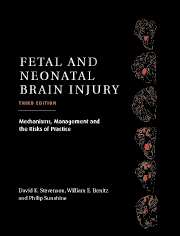Book contents
- Frontmatter
- Contents
- List of contributors
- Foreword
- Preface
- Part I Epidemiology, Pathophysiology, and Pathogenesis of Fetal and Neonatal Brain Injury
- 1 Perinatal asphyxia: an overview
- 2 Mechanisms of brain damage in animal models of hypoxia–ischemia in newborns
- 3 Cellular and molecular biology of perinatal hypoxic–ischemic brain damage
- 4 Fetal responses to asphyxia
- 5 Congenital malformations of the brain
- 6 Prematurity and complications of labor and delivery
- 7 Intrauterine growth retardation (restriction)
- 8 Hemorrhagic lesions of the central nervous system
- Part II Pregnancy, Labor, and Delivery Complications Causing Brain Injury
- Part III Diagnosis of the Infant with Asphyxia
- Part IV Specific Conditions Associated with Fetal and Neonatal Brain Injury
- Part V Management of the Depressed or Neurologically Dysfunctional Neonate
- Part VI Assessing the Outcome of the Asphyxiated Infant
- Index
- Plate section
1 - Perinatal asphyxia: an overview
from Part I - Epidemiology, Pathophysiology, and Pathogenesis of Fetal and Neonatal Brain Injury
Published online by Cambridge University Press: 10 November 2010
- Frontmatter
- Contents
- List of contributors
- Foreword
- Preface
- Part I Epidemiology, Pathophysiology, and Pathogenesis of Fetal and Neonatal Brain Injury
- 1 Perinatal asphyxia: an overview
- 2 Mechanisms of brain damage in animal models of hypoxia–ischemia in newborns
- 3 Cellular and molecular biology of perinatal hypoxic–ischemic brain damage
- 4 Fetal responses to asphyxia
- 5 Congenital malformations of the brain
- 6 Prematurity and complications of labor and delivery
- 7 Intrauterine growth retardation (restriction)
- 8 Hemorrhagic lesions of the central nervous system
- Part II Pregnancy, Labor, and Delivery Complications Causing Brain Injury
- Part III Diagnosis of the Infant with Asphyxia
- Part IV Specific Conditions Associated with Fetal and Neonatal Brain Injury
- Part V Management of the Depressed or Neurologically Dysfunctional Neonate
- Part VI Assessing the Outcome of the Asphyxiated Infant
- Index
- Plate section
Summary
Although there has been a marked reduction in perinatal morbidity and mortality rates over the past four decades, asphyxia in the perinatal period, leading to major motor and cognitive disabilities, continues to be a significant health problem worldwide. With a great deal of emphasis being placed on fetal monitoring, the rapid institution of appropriate resuscitative measures in depressed infants, as well as having more precision in the diagnosis and documentation of asphyxia, the mortality rate due to intrauterine hypoxia and birth asphyxia (ICD-9 code 768) has decreased by over 70% since 1979 in the USA. This trend has been noticed in Sweden and in the UK as well.
Despite these advances, a large number of infants with neurological abnormalities manifested by cerebral palsy, hearing or visual impairment, and mental retardation are born each year, many due to problems encountered during the birthing process. For many years, since W. J. Little's initial report linking neurological and mental handicaps in infants and children to abnormalities of labor and delivery, premature birth and asphyxia neonatorum, physicians in general and the lay public in particular have considered that birth trauma and “perinatal asphyxia” were the primary causes of handicaps in children. They also felt that had appropriate obstetrical and neonatal care been provided, the majority of such handicaps could have been prevented.
- Type
- Chapter
- Information
- Fetal and Neonatal Brain InjuryMechanisms, Management and the Risks of Practice, pp. 3 - 29Publisher: Cambridge University PressPrint publication year: 2003
- 4
- Cited by

